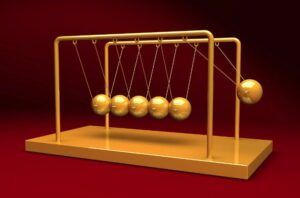What is the difference between classical and quantum worlds
One fundamental thing that physics does for us is to help us understand how our world works so we don’t assume that certain phenomena are magic.
So, to perfectly understand what is the difference between classical and quantum worlds, a simple analogy will do the magic. Now, think of a heap of sand, which you observe from afar. From your present angle, it looks continuous and smooth – even like one integral object. The heap of sand also appears as if you can take one chunk from it and cut it into various sizes of your choice. This current observation point is the perspective of the classical world.
However, as you edge closer to the heap of sand, you now see it clearly and understand that it is made up of tiny grains of sand. Interestingly enough, it is not continuous and smooth as you initially thought. Plus, you can cut it into fine indivisible units known as quanta. When you chop the heap of sand to get the smallest unit, you have 1 grain. To increase it, you can only get 2 grains, but not 1.5 grains. Remember, you earlier thought you could get any size you wanted. Sorry, but you can’t! This is so because you are not allowed or you are restricted from splitting the discrete grains into such units. That’s the whole idea or theory of quantization.
Basic Definitions
Before going into the key differences between the classical and quantum worlds, let us look at some definitions. Please note that “physics”, “field”, “world” and “mechanics” will be interchanged throughout this article.
The classical world describes the behavior of macroscopic objects whose speeds are relatively slower than the speed of light. Looking at the analogy above, macroscopic objects in this context represent the heap of sand. Therefore, this is a branch of physics that studies how objects exist in a specific place and time. This area primarily dwells on the mass, force and motion of objects.

In contrast, the quantum world examines the behaviour of microscopic particles, which are chiefly atoms, electrons, protons, and other molecular constituents. Back to the analogy above, you can liken the microscopic bodies to the grains of sand. Although the emphasis is usually on the microscopic matter, this area also studies macroscopic entities because you can get larger grains of sand as explained earlier.
What’s more, the quantum world also deals with the interaction of atoms and subatoms based on the observation that all forms of energy are released in discrete forms known as quanta. Until the concept started taking shape in the 20th Century, it used to look vague and counter intuitive.
Classical World versus Quantum World
The main disparities between them are discussed in detail below.
- Description of Objects: To be clear, classical physics focuses on the characteristics and movement of macroscopic or extremely big objects, such as the planets, stars, spacecraft, and galaxies. These are big objects (entities) that have speeds not more than that of light. They have also been accurately measured with results provided. For instance, the size of Planet Earth is 6,371km. Conversely, quantum physics has more complicated theories and deals with the behaviour and measurements of infinitesimal or microscopic objects. By and large, the focus here is on the properties of molecules and their constituents, such as electrons, protons, neutrons, and even esoteric particles (quarks and gluons). Therefore, here, people learn about the wave-particle duality, atoms, subatomic particles, wave function, etc.
- Data Processing: In the classical world, information is stored in either 0 or 1. The inputs are added in 0s and 1s. This is the same logic used to process data. In terms of voltage, this can also be interpreted as OFF (LOW) or ON (HIGH). A pair of bits can produce four values like 00, 01, 10, and 11. This means that if there are 3 bits, there are 8 values. It keeps increasing in that order. The implication is that more resources are required to process information fast with clock speed measured in gigahertz. On the other hand, the quantum world stores data as in qubits and leverages the principles of superposition and entanglement to achieve that. Superposition means that qubits can exist in two states (0 and 1) at the same time. This sounds great, right? Well, here’s the challenge: Qubits need to be alive (to be held for some time) to do any meaningful work. As a result, research studies are ongoing to achieve that. One of such studies was done at the University of Oxford, where researchers used silicon-28 to achieve superposition for 192 seconds.
- Subdivisions (Branches): When it comes to subdivisions, the classical field is divided into three: Newtonian, Lagrangian and Hamiltonian. The idea behind these subdivisions is based on the mathematical methods and quantities used for studying the movement of objects. Contrastingly, the quantum field is broadly categorized into two. Firstly, quantum mechanics of nonrelativistic bodies, which focuses on subatoms with speeds relatively smaller than the speed of light. Then the second category is the quantum mechanics of relativistic bodies, which studies the subatoms with speeds relatively compatible with the speed of light.
- Interaction (Touch): In the classical world, macroscopic objects can be seen and touched because they are considered tangible. You can touch your smartphone or the mouse of your computer and then scroll down the screen to read this article. However, that is not the case in the quantum world because the concepts of “solid” and “boundaries” don’t exist here. As a result, the whole idea of touching microscopic particles is a mere illusion.
- Applications: Classical mechanics is applied to concepts like optics, thermodynamics, electrodynamics, etc. Keep in mind that this world cannot be applied to microscopic bodies. On the flip side, quantum mechanics is applied to phenomena like superfluidity and superconductivity.
- Development: As far as the classical world is concerned, it is fully developed. Some notable names in this field are Sir Isaac Newton, who is considered the father of classical physics. Other iconic names include Galileo Galilei, Blaise Pascal, Robert Hooke, Thomas Young, etc. As for the quantum world, it is still developing and evolving. So far, some renowned pioneers are Albert Einstein, Max Planck, and Werner Heisenberg.
